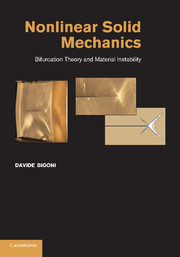Book contents
- Frontmatter
- Contents
- Preface
- Foreword by Giulio Maier
- 1 Introduction
- 2 Elements of tensor algebra and analysis
- 3 Solid mechanics at finite strains
- 4 Isotropic non-linear hyperelasticity
- 5 Solutions of simple problems in finitely deformed non-linear elastic solids
- 6 Constitutive equations and anisotropic elasticity
- 7 Yield functions with emphasis on pressure sensitivity
- 8 Elastoplastic constitutive equations
- 9 Moving discontinuities and boundary value problems
- 10 Global conditions of uniqueness and stability
- 11 Local conditions for uniqueness and stability
- 12 Incremental bifurcation of elastic solids
- 13 Applications of local and global uniqueness and stability criteria to non-associative elastoplasticity
- 14 Wave propagation, stability and bifurcation
- 15 Post-critical behaviour and multiple shear band formation
- 16 A perturbative approach to material instability
- References
- Index
- Plate section
16 - A perturbative approach to material instability
Published online by Cambridge University Press: 05 August 2012
- Frontmatter
- Contents
- Preface
- Foreword by Giulio Maier
- 1 Introduction
- 2 Elements of tensor algebra and analysis
- 3 Solid mechanics at finite strains
- 4 Isotropic non-linear hyperelasticity
- 5 Solutions of simple problems in finitely deformed non-linear elastic solids
- 6 Constitutive equations and anisotropic elasticity
- 7 Yield functions with emphasis on pressure sensitivity
- 8 Elastoplastic constitutive equations
- 9 Moving discontinuities and boundary value problems
- 10 Global conditions of uniqueness and stability
- 11 Local conditions for uniqueness and stability
- 12 Incremental bifurcation of elastic solids
- 13 Applications of local and global uniqueness and stability criteria to non-associative elastoplasticity
- 14 Wave propagation, stability and bifurcation
- 15 Post-critical behaviour and multiple shear band formation
- 16 A perturbative approach to material instability
- References
- Index
- Plate section
Summary
A perturbative approach tomaterial instabilities is introduced, in which a perturbing agent is superimposed on a homogeneously stressed and strained infinite medium. The perturbing agent may be a concentrated force, a dipole, but also a fracture, or a rigid inclusion, or a pre-existing shear band. It is shown that the technique is ‘rich enough’ to reveal phenomena which remain undetected with more conventional approaches. These involve effects of pre-stress on dislocation-induced distorsions; dynamics of shear bands; field solutions for materials in flutter conditions; interactions between shear bands, cracks and rigid inclusions; and features related to shear band growth. In particular, shear band growth is shown to have a definite tendency toward rectilinear propagation and to involve a stress field singularity akin to the singularity arising at a fracture tip. These results motivate the circumstance that shear bands are preferential near-failure deformation modes.
All analyses considered up to this point refer to situations of perfect systems loaded in perfect conditions. We are now in a position to judge the merits and the limits of the previous approach and to set up a new methodology that may capture aspects remaining undetected within the previously given framework. These aspects can be illustrated with reference to two examples: the local instability criteria of ellipticity loss and flutter instability. In particular, we know that both refer to homogeneously deformed infinite bodies and that the former is linked to the appearance of shear bands (or strain localisation), whereas the latter is linked to the generation of ‘blowing-up incremental solutions’.
- Type
- Chapter
- Information
- Nonlinear Solid MechanicsBifurcation Theory and Material Instability, pp. 444 - 506Publisher: Cambridge University PressPrint publication year: 2012



